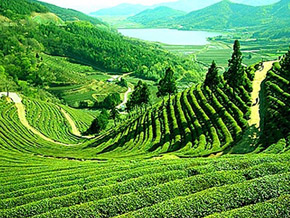Happy Valley Tea Garden
Darjeeling
<div><div>The estate was established in 1854 making it oldest tea estate of Darjeeling, and at a height of 6,800 feet, it is also one of the highest tea factories in the world. David Wilson, an Englishman, had named the garden Wilson Tea Estate and by 1860 had started cultivation of tea. In 1903, the estate was taken over by an Indian, Tarapada Banerjee, an aristocrat from Hooghly. In 1929, Banerjee bought the Windsor Tea Estate nearby, and merged the two estates under the name of Happy Valley Tea Estate. G.C. Banerjee was the next owner of Happy Valley Tea Estate. He with his wife Annapurna Devi and three daughters (Nonimukhi, Monmaya and Savitri) lived there for some time. Annapurna Devi was related to the Ganguly family of Khandwa; her maternal uncle was Kunjalal Bihari, father of the famous cine Gangulys.</div><div><br></div><div>In March 2007, after remaining nearly dormant for nearly four years as the tea industry had experienced a slump, the estate was bought over by S K Bansal, of Ambotia Tea Group, which established a new factory within the premises, and started modernization process, replating and switching to organic farming. Finally, the estate reopened to public in 2008, with the original factory turned into a working museum. It also displayed single piston slow-speed engines, and the shaft machines and sells tea-related mementos. The tea estate is spread over 437 acres, at a height of 6,800 ft. (2,100 m). The bushes in the garden are very old — the minimum age is 80 years, and some are 150 years old. Very little re-plantation has been done in the recent past. Situated around 3 km north of town, below Hill Cart Road, accessible via Lochnager Road from Chowk Bazaar, this tea estate is the closest tea estate to Darjeeling town, and tourists often visit the garden. The months of March to May are the busiest time here, when plucking and processing are in progress. It is open Tuesday to Saturday from 8 a.m. to 4 p.m.</div><div>There are seasons for different types of tea. Green and little bit of White Tea are plucked during March to May. June to August is the season for Black Tea. September to November is again the season for Green and White Tea. During the other months (December to February), teas are not plucked and the machines do not operate. The teas produced at the Happy Valley Tea Estates are all exported. Harrods in London is the main distributor of the tea.</div><div><br></div><div>A committee with 10 members was formed that was responsible for the development and management of the center. Ms Gaylo Thondup was the first President of the center. One of the prominent members of the first committee was Tenzing Norgay who climbed the Everest in May 1953 with Edmund Hillary.</div><div>A small center that started with only 4 workers with the objective of self rehabilitation and helping the under-privileged Tibetan community in the area has now grown to accommodate more than 650 Tibetan refugees. You will see Tibetan men and women making exquisite hand crafted items like woolen shawls & carpets, carved wooden crafts, leather jackets, coats and lots of other items. They have a training center that imparts skills to the new workers.</div><div><br></div><div>Here you will see all the hand crafted items on sale. There are many ladies jackets, carpets, gloves, woolen aprons, bags, various types of curios, small models of Buddha, cards, pouches, carved wooden items, hand painted scenery and pictures of Tibetan women on cloth pieces, and many other items.</div><div>There is a small counter where two Tibetan women help with the transactions. There is a board that says “Fixed Price†which essentially means no bargaining. A Hindi music usually plays here in the background.</div><div><br></div><div>The factory of the Tibetan Refugee Self Help Center where the all the handicraft items are made, is located at a place known as Hill Side. From Lebong Cart Road opposite to the Rangeet Valley Tea Estate, a narrow steep road on the right goes uphill. This winding road leads to the center. From Darjeeling town center, it takes about 20 minutes to reach the center by car.</div></div>
